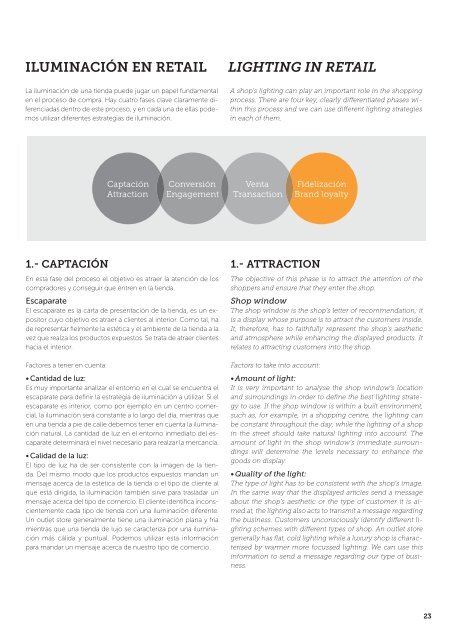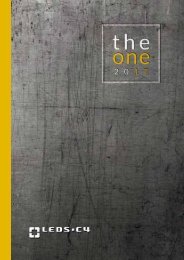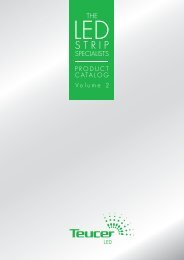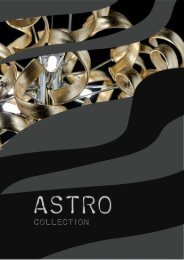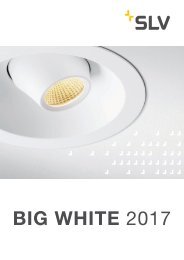RETAIL_2016
You also want an ePaper? Increase the reach of your titles
YUMPU automatically turns print PDFs into web optimized ePapers that Google loves.
ILUMINACIÓN EN <strong>RETAIL</strong><br />
La iluminación de una tienda puede jugar un papel fundamental<br />
en el proceso de compra. Hay cuatro fases clave claramente diferenciadas<br />
dentro de este proceso, y en cada una de ellas podemos<br />
utilizar diferentes estrategias de iluminación.<br />
LIGHTING IN <strong>RETAIL</strong><br />
A shop’s lighting can play an important role in the shopping<br />
process. There are four key, clearly differentiated phases within<br />
this process and we can use different lighting strategies<br />
in each of them.<br />
Attraction<br />
Engagement<br />
Transaction<br />
Brand loyalty<br />
1.- CAPTACIÓN<br />
En esta fase del proceso el objetivo es atraer la atención de los<br />
compradores y conseguir que entren en la tienda.<br />
Escaparate<br />
El escaparate es la carta de presentación de la tienda, es un expositor<br />
cuyo objetivo es atraer a clientes al interior. Como tal, ha<br />
de representar fielmente la estética y el ambiente de la tienda a la<br />
vez que realza los productos expuestos. Se trata de atraer clientes<br />
hacia el interior.<br />
Factores a tener en cuenta:<br />
• Cantidad de luz:<br />
Es muy importante analizar el entorno en el cual se encuentra el<br />
escaparate para definir la estrategia de iluminación a utilizar. Si el<br />
escaparate es interior, como por ejemplo en un centro comercial,<br />
la iluminación será constante a lo largo del día, mientras que<br />
en una tienda a pie de calle debemos tener en cuenta la iluminación<br />
natural. La cantidad de luz en el entorno inmediato del escaparate<br />
determinará el nivel necesario para realzar la mercancía.<br />
• Calidad de la luz:<br />
El tipo de luz ha de ser consistente con la imagen de la tienda.<br />
Del mismo modo que los productos expuestos mandan un<br />
mensaje acerca de la estética de la tienda o el tipo de cliente al<br />
que está dirigida, la iluminación también sirve para trasladar un<br />
mensaje acerca del tipo de comercio. El cliente identifica inconscientemente<br />
cada tipo de tienda con una iluminación diferente.<br />
Un outlet store generalmente tiene una iluminación plana y fría<br />
mientras que una tienda de lujo se caracteriza por una iluminación<br />
más cálida y puntual. Podemos utilizar esta información<br />
para mandar un mensaje acerca de nuestro tipo de comercio.<br />
1.- ATTRACTION<br />
The objective of this phase is to attract the attention of the<br />
shoppers and ensure that they enter the shop.<br />
Shop window<br />
The shop window is the shop’s letter of recommendation; it<br />
is a display whose purpose is to attract the customers inside.<br />
It, therefore, has to faithfully represent the shop’s aesthetic<br />
and atmosphere while enhancing the displayed products. It<br />
relates to attracting customers into the shop.<br />
Factors to take into account:<br />
• Amount of light:<br />
It is very important to analyse the shop window’s location<br />
and surroundings in order to define the best lighting strategy<br />
to use. If the shop window is within a built environment,<br />
such as, for example, in a shopping centre, the lighting can<br />
be constant throughout the day, while the lighting of a shop<br />
in the street should take natural lighting into account. The<br />
amount of light in the shop window’s immediate surroundings<br />
will determine the levels necessary to enhance the<br />
goods on display.<br />
• Quality of the light:<br />
The type of light has to be consistent with the shop’s image.<br />
In the same way that the displayed articles send a message<br />
about the shop’s aesthetic or the type of customer it is aimed<br />
at, the lighting also acts to transmit a message regarding<br />
the business. Customers unconsciously identify different lighting<br />
schemes with different types of shop. An outlet store<br />
generally has flat, cold lighting while a luxury shop is characterised<br />
by warmer more focussed lighting. We can use this<br />
information to send a message regarding our type of business.<br />
23


